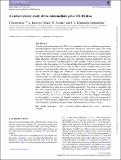Files in this item
A radial velocity study of the intermediate polar EX Hydrae
Item metadata
| dc.contributor.author | Echevarría, J. | |
| dc.contributor.author | Ramírez-Torres, A. | |
| dc.contributor.author | Michel, R. | |
| dc.contributor.author | Hernández Santisteban, J. V. | |
| dc.date.accessioned | 2019-09-17T15:30:03Z | |
| dc.date.available | 2019-09-17T15:30:03Z | |
| dc.date.issued | 2016-09-11 | |
| dc.identifier | 261035934 | |
| dc.identifier | 79f72cc8-01f2-4968-9bf0-f78493ef306e | |
| dc.identifier | 84982291641 | |
| dc.identifier.citation | Echevarría , J , Ramírez-Torres , A , Michel , R & Hernández Santisteban , J V 2016 , ' A radial velocity study of the intermediate polar EX Hydrae ' , Monthly Notices of the Royal Astronomical Society , vol. 461 , no. 2 , pp. 1576-1589 . https://doi.org/10.1093/mnras/stw1425 | en |
| dc.identifier.issn | 0035-8711 | |
| dc.identifier.other | BibCode: 2016MNRAS.461.1576E | |
| dc.identifier.other | ORCID: /0000-0002-6733-5556/work/61370244 | |
| dc.identifier.uri | https://hdl.handle.net/10023/18494 | |
| dc.description.abstract | A study on the intermediate polar EX Hya is presented, based on simultaneous photometry and high-dispersion spectroscopic observations, during four consecutive nights. The strong photometric modulation related to the 67-min spin period of the primary star is clearly present, as well as the narrow eclipses associated with the orbital modulation. Since our eclipse timings have been obtained almost 91 000 cycles since the last reported observations, we present new linear ephemeris, although we cannot rule out a sinusoidal variation suggested by previous authors. The system shows double-peaked H α, H β and He I λ5876 Å emission lines, with almost no other lines present. As H α is the only line with enough S/N ratio in our observations, we have concentrated our efforts in its study, in order to obtain a reliable radial velocity semi-amplitude. From the profile of this line, we find two important components; one with a steep rise and velocities not larger than ˜1000 km s-1 and another broader component extending up to ˜2000 km s-1, which we interpret as coming mainly from the inner disc. A strong and variable hotspot is found and a stream-like structure is seen at times. We show that the best solution correspond to K1 = 58 ± 5 kms-1 from H α, from the two emission components, which are both in phase with the orbital modulation. We remark on a peculiar effect in the radial velocity curve around phase zero, which could be interpreted as a Rositter-MacLaughlin-like effect, which has been taken into account before deriving K1. This value is compatible with the values found in high resolution both in the ultraviolet and X-ray. Using the published inclination angle of I =78° ±1° and semi-amplitude K2 = 432 ± 5 kms-1, we find: M1 = 0.78 ± 0.03M⊙, M2 = 0.10 ± 0.02 M⊙ and a = 0.67 ± 0.01 R⊙. Doppler Tomography has been applied, to construct six Doppler tomograms for single orbital cycles spanning the four days of observations to support our conclusions. Our results indicate that EX Hya has a well-formed disc and that the magnetosphere should extend only to about 3.75 RWD. | |
| dc.format.extent | 8009905 | |
| dc.language.iso | eng | |
| dc.relation.ispartof | Monthly Notices of the Royal Astronomical Society | en |
| dc.subject | Techniques: radial velocities | en |
| dc.subject | Eclipses | en |
| dc.subject | Ephemerides | en |
| dc.subject | Novae | en |
| dc.subject | Cataclysmic variables | en |
| dc.subject | QB Astronomy | en |
| dc.subject | QC Physics | en |
| dc.subject | DAS | en |
| dc.subject.lcc | QB | en |
| dc.subject.lcc | QC | en |
| dc.title | A radial velocity study of the intermediate polar EX Hydrae | en |
| dc.type | Journal article | en |
| dc.contributor.institution | University of St Andrews. School of Physics and Astronomy | en |
| dc.identifier.doi | https://doi.org/10.1093/mnras/stw1425 | |
| dc.description.status | Peer reviewed | en |
| dc.identifier.url | https://arxiv.org/abs/1606.03734 | en |
| dc.identifier.url | http://adsabs.harvard.edu/abs/2016MNRAS.461.1576E | en |
This item appears in the following Collection(s)
Items in the St Andrews Research Repository are protected by copyright, with all rights reserved, unless otherwise indicated.

